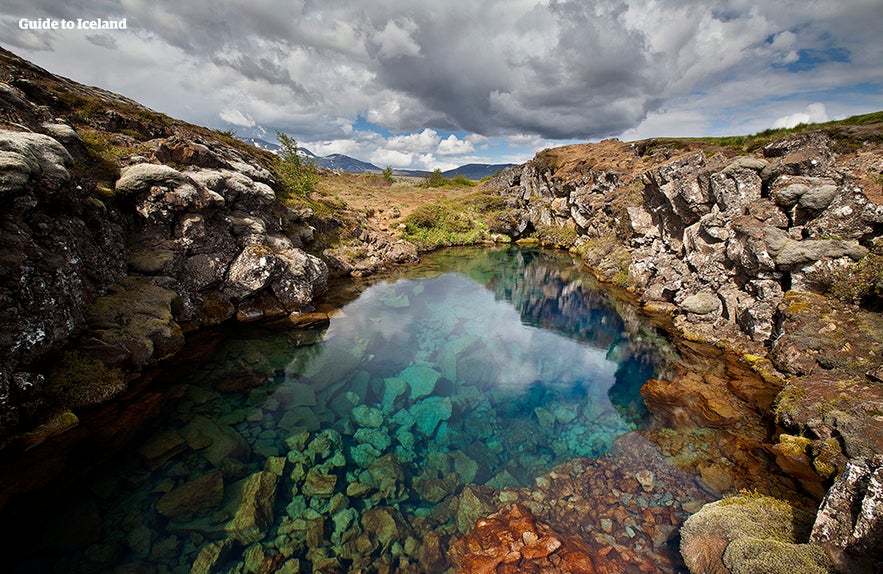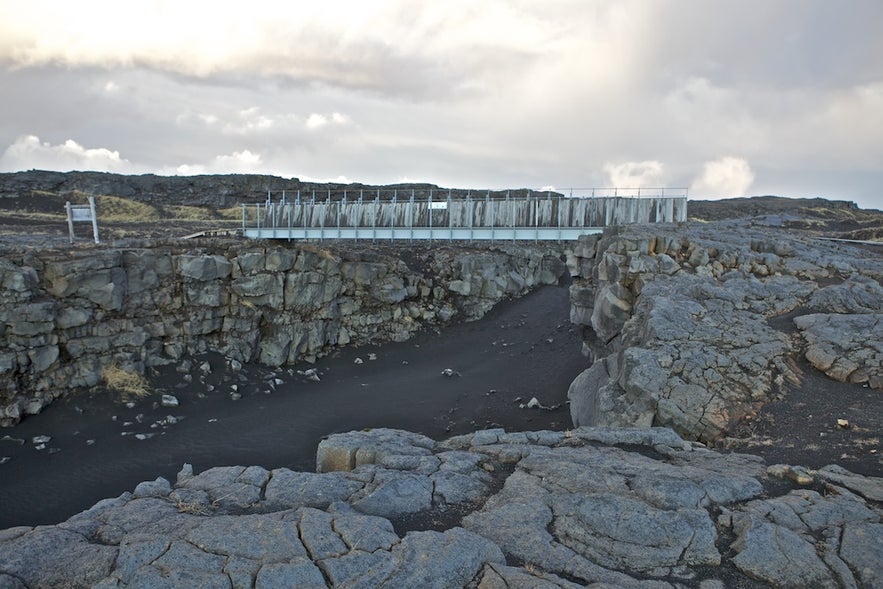Mid-Atlantic Ridge Travel Guide

Visit the stunning location on your trip to Iceland by taking a Golden Circle day tour with a stop at Thingvellir National Park, where you can even book a snorkeling tour in the Silfra fissure between the continent. Consider choosing a private tour of the Reykjanes peninsula to walk across the picturesque Bridge Between Continents, called Miðlína in Icelandic.
The Mid-Atlantic Ridge is a massive underwater mountain range that runs through the middle of the Atlantic Ocean. It is the boundary where the Eurasian and North American tectonic plates meet and move apart from each other.
Iceland sits on this ridge, making it a unique geological location.
The movement of the plates causes constant volcanic and seismic activity in Iceland, creating a diverse landscape of hot springs, geysers, and rugged terrain. Visitors to Iceland can enjoy this unique feature at Thingvellir National Park, along the famous Golden Circle route, or on the Reykjanes peninsula to the west of Reykjavik.
Location of the Mid-Atlantic Ridge
The Mid-Atlantic Ridge is a massive mountain range that runs through the middle of the Atlantic Ocean, from the Arctic Ocean in the north to the southern Atlantic near Antarctica.
It is a divergent plate boundary where the Eurasian and North American tectonic plates move apart from each other, creating new oceanic crust.
The Mid-Atlantic Ridge is one of the longest mountain ranges in the world, stretching for over 9,900 miles (16,000 kilometers), and it plays a crucial role in the geology of the Earth and Iceland’s unique geological features.
The movement of tectonic plates along the Mid-Atlantic Ridge is responsible for the formation of Iceland, which is situated on the ridge's westernmost section. Iceland is one of the only places on Earth where the Mid-Atlantic Ridge is visible above sea level.
The ridge cuts through Iceland, meaning some regions are on the North American tectonic plate and others are on the Eurasian plate. Reykjavik, for example, is part of North America, while the Eastfjords are part of Europe.
It is possible to visit where the continents are pulling apart, most notably at Thingvellir National Park and the Reykjanes peninsula.
Iceland’s Formation and Geology
Iceland's formation is closely linked to the Mid-Atlantic Ridge, and its current unique geology and geothermal features are due to the tectonic activity along the ridge.
Iceland is situated directly above the ridge's westernmost section. The movement of these plates creates new oceanic crust and causes volcanic and seismic activity, which is why Iceland is a land of active volcanoes, hot springs, and rugged terrain.
The process of Iceland's formation began around 25 million years ago when the North American and Eurasian tectonic plates began to move apart. This movement created a rift valley along the Mid-Atlantic Ridge, which eventually led to the formation of a series of volcanoes.
Over time, the volcanic activity in Iceland became more intense, leading to the formation of the island's distinctive landscape.
The volcanic activity in Iceland is fueled by the mantle plume, which is a column of hot rock that rises from deep within the earth's mantle. As the plume rises, it causes mantle material to melt, which then rises to the surface and forms new volcanic rock.
This process is ongoing, and Iceland continues to be shaped by the forces of plate tectonics and volcanic activity.
The Mid-Atlantic Ridge also plays a crucial role in Iceland's geothermal features. The movement of the tectonic plates creates fractures in the earth's crust, which allow water to seep down to the rocks beneath before being heated by the magma and rising back to the surface as hot springs and geysers.
Iceland's position on the Mid-Atlantic Ridge makes it a hotspot for volcanic activity and geothermal energy, and the country has become a leader in the use of geothermal energy for electricity production and heating. Iceland’s capital, Reykjavik, is heated entirely by geothermal energy, and the country produces nearly 30% of its electricity from geothermal sources.
The Mid-Atlantic Ridge at Thingvellir
Travelers interested in visiting the Mid-Atlantic Ridge during their time in Iceland are best off heading to Thingvellir National Park or the Reykjanes peninsula. Both locations are great options for anyone looking to walk between continents.
Thingvellir National Park is about 25 miles (40 kilometers) from Reykjavik along the famous Golden Circle route. You can easily drive yourself or book one of the numerous Golden Circle guided tours that depart from the capital.
Once you arrive at Thingvellir, you can explore the park's hiking trails, visit the Silfra fissure, and learn about Iceland's history and culture at the visitor center. Thingvellir has a rich and fascinating history that dates back to the Viking Age.
The site was established as the meeting place of Iceland's national parliament, the Althing, or Alþingi in Icelandic, in the year 930, making it one of the oldest parliaments in the world. Today, Thingvellir National Park is a UNESCO World Heritage site, and visitors can still see the remains of the Althing's meeting place, including the Law Rock, where the chieftains would stand to make speeches and recite laws.
Snorkeling and Scuba Diving at the Mid-Atlantic Ridge
For a unique experience, adventurous travelers can book a tour of the Silfra fissure, where you can snorkel or dive between the continents. Silfra is a fissure located in Thingvellir National Park, and it is one of the world's most famous snorkeling and scuba diving sites.
The crystal-clear water in Silfra comes from the nearby Langjokull glacier and is filtered through porous lava rocks for up to 30 years before it reaches the fissure. The water is so clear that you can see up to 330 feet (100 meters) underwater, making for an incredible snorkeling experience.
During the snorkeling tour, visitors will swim between the two tectonic plates of North America and Europe and witness the unique geological formations and vibrant underwater colors.
The water in Silfra is cold, with temperatures ranging from 35-30 degrees Fahrenheit (2-4 Celsius). Drysuits will prevent your body from getting wet, but snorkeling is possible in a wetsuit.
The Mid-Atlantic Ridge on the Reykjanes Peninsula
 Photo from Wikimedia, Creative Commons, by josef knecht. No edits made.
Photo from Wikimedia, Creative Commons, by josef knecht. No edits made.
The Reykjanes peninsula is another location in Iceland where the Mid-Atlantic Ridge is visible. The peninsula is home to many hot springs, geysers, and volcanic craters that are popular with visitors, in addition to the Bridge Between Continents at Sandvik.
The Bridge Between Continents in Sandvik is a unique site located on the Mid-Atlantic Ridge in Iceland. It is a small footbridge that spans a narrow channel between two continents of North America and Europe.
The bridge is a symbolic representation of the connection between the two tectonic plates and the geological forces that shaped Iceland. Visitors to the bridge can stand with one foot on the North American plate and one foot on the European plate, providing a unique and memorable photo opportunity.
Visiting the Mid-Atlantic Ridge at Thingvellir National Park and the Reykjanes peninsula is a must-see destination for anyone interested in geology, history, or outdoor adventure.
Attractions Nearby
Popular categories

Download Iceland’s biggest travel marketplace to your phone to manage your entire trip in one place
Scan this QR code with your phone camera and press the link that appears to add Iceland’s biggest travel marketplace into your pocket. Enter your phone number or email address to receive an SMS or email with the download link.


















